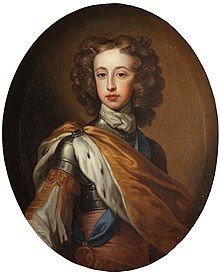William, Duke of Gloucester
| Prince William | |
|---|---|
| Duke of Gloucester | |

Portrait by Sir Godfrey Kneller, c. 1700
|
|
| Born |
24 July 1689 Hampton Court Palace, London |
| Died | 30 July 1700 (aged 11) Windsor Castle, Windsor, Berkshire |
| Burial | 9 August 1700 Westminster Abbey, London |
| House | Oldenburg |
| Father | Prince George of Denmark |
| Mother | Princess Anne, later Queen of Great Britain |
Prince William, Duke of Gloucester (24 July 1689 – 30 July 1700), was the son of Princess Anne, later Queen of England, Ireland and Scotland from 1702, and her husband, Prince George, Duke of Cumberland. He was their only child to survive infancy. Styled Duke of Gloucester, he was viewed by contemporaries as a Protestant champion because his birth seemed to cement the Protestant succession established in the "Glorious Revolution" that had deposed his Catholic grandfather James II the previous year.
Gloucester's mother was estranged from her brother-in-law and cousin, William III, and her sister, Mary II, but supported links between them and her son. He grew close to his uncle William, who created him a Knight of the Garter, and his aunt Mary, who frequently sent him presents. At his nursery in Campden House, Kensington, he befriended his Welsh body-servant, Jenkin Lewis, whose memoir of the Duke is an important source for historians, and operated his own miniature army, called the "Horse Guards", which eventually comprised 90 boys.
Gloucester's precarious health was a constant source of worry to his mother. His death, in 1700 at the age of eleven, precipitated a succession crisis as his mother was the only individual remaining in the Protestant line of succession established by the Bill of Rights 1689. The English Parliament did not want the throne to revert to a Catholic, and so passed the Act of Settlement 1701, which settled the throne of England on Electress Sophia of Hanover, a cousin of King James II, and her Protestant heirs.
In late 1688, in what became known as the "Glorious Revolution", the Roman Catholic King James of England, Scotland and Ireland was deposed by his Protestant nephew and son-in-law, Dutch stadtholder William Henry of Orange. William and his wife, James's elder daughter Mary, were recognised by the English and Scottish parliaments as king and queen. As they had no children, Mary's younger sister, Anne, was designated their heiress presumptive in England and Scotland. The accession of William and Mary and the succession through Anne were enshrined in the Bill of Rights 1689.
...
Wikipedia
